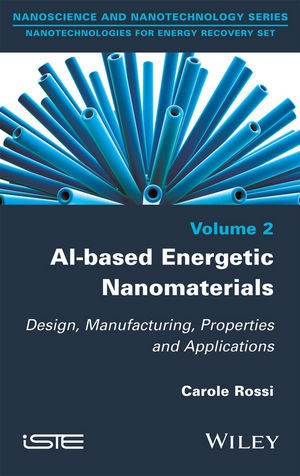Fr. 100.00
Carole Rossi
Al-based Energetic Nano Materials - Design, Manufacturing, Properties and Applications
Englisch · Fester Einband
Versand in der Regel in 3 bis 5 Wochen
Beschreibung
Over the past two decades, the rapid development of nanochemistry and nanotechnology has allowed the synthesis of various materials and oxides in the form of nanopowders making it possible to produce new energetic compositions and nanomaterials.
This book has a bottom-up structure, from nanomaterials synthesis to the application fields. Starting from aluminum nanoparticles synthesis for fuel application, it proposes a detailed state-of-the art of the different methods of preparation of aluminum-based reactive nanomaterials. It describes the techniques developed for their characterization and, when available, a description of the fundamental mechanisms responsible for their ignition and combustion. This book also presents the possibilities and limitations of different energetic nanomaterials and related structures as well as the analysis of their chemical and thermal properties. The whole is rounded off with a look at the performances of reactive materials in terms of heat of reaction and reactivity mainly characterized as the self-sustained combustion velocity. The book ends up with a description of current reactive nanomaterials applications underlying the promising integration of aluminum-based reactive nanomaterial into micro electromechanical systems.
Inhaltsverzeichnis
INTRODUCTION ix
ACKNOWLEDGEMENTS xi
CHAPTER 1. NANOSIZED ALUMINUM AS METAL FUEL 1
1.1. Al nanoparticles manufacturing 2
1.1.1. Vapor-phase condensation methods 2
1.1.2. Wet chemistry 6
1.1.3. Mechanical methods 7
1.2. Example of Al nanoparticles passivation technique 8
1.2.1. Metallic coating 9
1.2.2. Organic coating 9
1.3. Characterization of Al nanoparticles properties 11
1.3.1. Light scattering methods 12
1.3.2. Gas adsorption method: specific surface measurement, BET diameter 13
1.3.3. Thermal analysis: purity or aluminum content percentage and oxide thickness 13
1.3.4. Chemical analysis 15
1.4. Oxidation of aluminum: basic chemistry and models 16
1.4.1. Initial stage of aluminum oxidation from first principles calculations 16
1.4.2. Thermodynamic modeling of Al oxidation under low heating rate 18
1.5. Why incorporate Al nanoparticles into propellant and rocket technology? 23
1.5.1. Reduction of the melting point 24
1.5.2. Increase in the reactivity 25
CHAPTER 2. APPLICATIONS: AL NANOPARTICLES IN GELLED PROPELLANTS AND SOLID FUELS 27
2.1. Gelled propellants 27
2.2. Solid propellants 29
2.3. Solid fuel 31
CHAPTER 3. APPLICATIONS OF AL NANOPARTICLES: NANOTHERMITES 33
3.1. Method of preparation 35
3.1.1. Ultrasonic nanopowder mixing 36
3.1.2. Rapid expansion of a supercritical dispersion 38
3.1.3. Molecular self-assembly of nanoparticles 39
3.2. Key parameters 42
3.2.1. The bulk density, theoretical density and compaction 42
3.2.2. The stochiometry 44
3.2.3. The size of Al and oxidizer particles 46
3.2.4. The passivation layer 49
3.3. Pressure generation tests 50
3.4. Combustion tests 52
3.4.1. Open tray experiments 52
3.4.2. Optical temperature measurement: spectroscopy 53
3.4.3. Photodiodes 54
3.4.4. Confined combustion tests 54
3.5. Ignition tests 56
3.5.1. Impact ignition 56
3.5.2. High-rate heating (106-107°C/s) 57
3.5.3. Low and uniform heating (10-100°C/s) 57
3.6. Electrostatic discharge (ESD) sensitivity tests 58
CHAPTER 4. OTHER REACTIVE NANOMATERIALS AND NANOTHERMITE SYSTEMS 63
4.1. Sol-gel materials 63
4.2. Reactive multilayered foils 66
4.2.1. Bimetallic multilayered foils 67
4.2.2. Thermite multilayered foils 72
4.2.3. Summary 77
4.3. Dense reactive materials 77
4.3.1. Arrested reactive milling 78
4.3.2. Cold-spray consolidation 81
4.4. Core-shell structures 83
4.5. Reactive porous silicon 86
4.6. Other energetic systems 88
CHAPTER 5. COMBUSTION AND PRESSURE GENERATION MECHANISMS 91
5.1. General views of Al particle combustion: micro versus nano, diffusion-based kinetics 93
5.2. Stress in the oxide layer and shrinking core model 95
5.3. Aluminum oxidation through diffusion-reaction mechanisms 97
5.4. Melt-dispersion mechanism 99
5.5. Gas and pressure generation in nanothermites 100
5.5.1. Thermodynamic models 100
5.5.2. Application to Al/CuO 103
CHAPTER 6. APPLICATIONS 107
6.1. Reactive bonding 108
6.2. Microignition chips 110
6.3. Microactuation/propulsion 113
6.3.1. High energetic actuators 113
6.3.2. Fast impulse nanothermite thrusters 113
6.3.3. Smooth actuators 116
6.4. Materia
Über den Autor / die Autorin
Carole Rossi, CNRS Director of Research, Head of NanoEngineering and Integration Research Area.
Zusammenfassung
Over the past two decades, the rapid development of nanochemistry and nanotechnology has allowed the synthesis of various materials and oxides in the form of nanopowders making it possible to produce new energetic compositions and nanomaterials.
This book has a bottom-up structure, from nanomaterials synthesis to the application fields. Starting from aluminum nanoparticles synthesis for fuel application, it proposes a detailed state-of-the art of the different methods of preparation of aluminum-based reactive nanomaterials. It describes the techniques developed for their characterization and, when available, a description of the fundamental mechanisms responsible for their ignition and combustion. This book also presents the possibilities and limitations of different energetic nanomaterials and related structures as well as the analysis of their chemical and thermal properties. The whole is rounded off with a look at the performances of reactive materials in terms of heat of reaction and reactivity mainly characterized as the self-sustained combustion velocity. The book ends up with a description of current reactive nanomaterials applications underlying the promising integration of aluminum-based reactive nanomaterial into micro electromechanical systems.
Produktdetails
| Autoren | Carole Rossi |
| Verlag | Wiley & Sons |
| Sprache | Englisch |
| Produktform | Fester Einband |
| Erschienen | 30.11.2015 |
| EAN | 9781848217171 |
| ISBN | 978-1-84821-717-1 |
| Seiten | 170 |
| Abmessung | 156 mm x 239 mm x 15 mm |
| Gewicht | 666 g |
| Themen |
Naturwissenschaften, Medizin, Informatik, Technik
> Technik
> Elektronik, Elektrotechnik, Nachrichtentechnik
Electrical & Electronics Engineering, Elektrotechnik u. Elektronik, Nanomaterial, MEMS |
Kundenrezensionen
Zu diesem Artikel wurden noch keine Rezensionen verfasst. Schreibe die erste Bewertung und sei anderen Benutzern bei der Kaufentscheidung behilflich.
Schreibe eine Rezension
Top oder Flop? Schreibe deine eigene Rezension.

